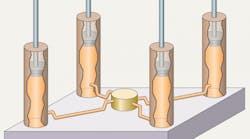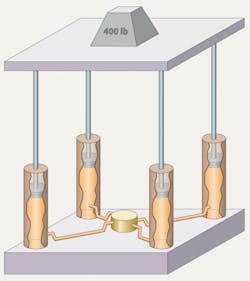The Old Timer of Royal Oak, Mich., was a regular contributor to H&P years before we ever even heard of the internet. But most of his advice is just as ueful — and interesting — today.
So rather than leave his wisdom printed on pages archived in our storage room, I pulled out issues from the late 1980s and early 1990s and have been reproducing relevant entries in this blog. Here is my 13th entry, which was originally published in the January 1989 issue:
One of our satellite plants needed a platform, about the size of a card table, to raise and lower a differential assembly and fixture weighing about 400 lb. Instead of taking this project to engineering, they asked a couple of our maintenance guys to put something together. These guys came up with four hydraulic cylinders — one for each corner of the platform — hooked them up to a central distribution manifold with 3/8-in. copper tubing, piped in a 4-way directional valve, and powered the system with a small gear pump.
Experience would mandate that there’s no way this simple arrangement could synchronize the speed of the four cylinders to stroke in unison without binding in one corner. Yet, the first time I saw this setup, the platform was moving smoothly and had been for some time.
The key was in tuning the copper tubing — with a hammer and a piece of hardened steel. The designers tested their platform with a level on it, and when they observed one cylinder getting ahead of the others, they’d rap its inlet line to create a slight restriction. Then they’d start over.
I don’t know how many hours, days, or weeks it took to tune all four feed lines, but when they were done, the platform lifted perfectly.


